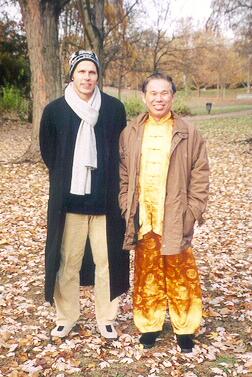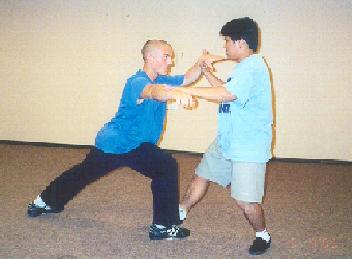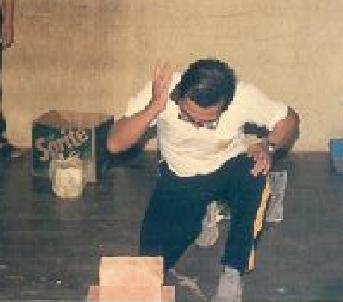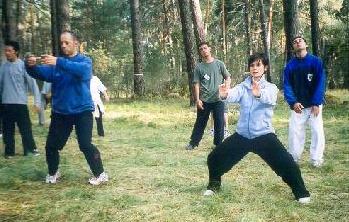January 2004 (Part 1)
SELECTION OF QUESTIONS AND ANSWERS

Grandmaster Kai Uwe Jettkandt and Sifu Wong in Frankfurt
Question 1
While surfing in the Internet, searching about chi and ways to develop it, I found your page July 2003 Pafrt 3. I don't know why I did it, since I had made a promise to myself of never to waste my time with these things again. This promise was made after a couple of years searching for a martial art that would REALLY use chi/ki, and never finding the real thing.
— Ricardo, Portugal
Answer
According to Buddhist teaching, there are no co-incidences. Every event is due to karma, the law of cause and effect.
You did not meet real chi kung masters because of your bad karma. (“Bad” here is in relation to the evens of meeting real chi kung masters. It may be “good” in other aspects.) You came across my webpage on chi kung which rekindled your hopes because of good karma. Whether you will learn real chi kung and benefit from it will depend on your subsequent karma.
Using the term “karma” here is summarizing a lot of descriptions and explanations in a nutshell. There is nothing superstitious or religious about karma. Although the manifestations and consequences may be countless and profound, basically karma refers to a matrix of causes and effects. In your case, for example, you were in environments and situations where real chi kung did not occur, or if it occurred you missed it for some reasons.
There is no surprise that you and most people have little or no opportunities to meet genuine chi kung. The main reason is that real chi kung masters are extremely rare today, even in China. Another reason is that amongst the real masters, very, very few are bothered to teach or even explain it.
The third reason is that even if real chi kung is taught or explained, like I do as a mission, most people would not believe it. On the other hand, many of those who claim to teach chi kung are often bogus or the chi kung they teach is so low a level that its effects are nothing more than those of physical exercise.
Considering these factors, you should consider yourself lucky to come across my webpage and take the trouble to write to me. It is also interesting that the main photograph on the webpage in question shows Kai Uwe Jettkandt, who had spent more than 20 years searching for the wonders of chi kung and internal force.
He spent many years off work traveling in China and all over Asia in his search, meeting and having friendly sparring with some of their best known masters, but most of the times he was disappointed. Many times he almost gave up his search, thinking that chi and internal force could be mere myths.
Kai met me about seven years ago. Although he was already a Jujitsu grandmaster and a master of seven other martial arts then, he learned Shaolin Kungfu and chi kung from me. He is now one of the best practitioners in our international Shaolin Wahnam organization, and we are very proud of him.
In October last year, he made a very important decision. He gave up the teaching of all other martial arts, leaving them to his students who themselves are masters, so that he could focus on teaching only Shaolin Kungfu and chi kung. He said one must be true to what he believed — a principle all of us in Shaolin Wahnam cherish. Shaolin Kungfu, Kai explains, is the only martial art that fulfills all his three aspirations in one, namely combat efficiency, excellent health and spiritual cultivation.
Question 2
I started by practicing Judo, (nowadays it's more a sport than a martial art) and I eventually got tired of competitions, and the fact that the physically stronger always won.
Answer
Judo was invented as a sport, and was never intended to be a fighting art. Its founder, Sensei Jigoro Kano (1860-1938), eliminated dangerous techniques from Jujitsu and invented a new system which he called Judo.
Aikido, Karate-do, Kendo, Taekwondo, and Hapkido are also sports. Some martial art historians explain that the suffix “do”, which is the Japanese word for “way”, indicates that the art in question is a sport, derived from its classical martial counterpart with the suffix “jitsu”, which means “techniques”. For example, from Jujitsu which is a martial art, is derived Judo, and from Kenjitsu, the martial art of the samurai swordsmen, is derived Kendo.
While this distinction between “do” and “jitsu” is illuminating, it is not all abiding. The Japanese “jitsu” is pronounced as “shu” in Chinese. “Wushu”, which is the present official Chinese term for kungfu and which literally means “martial techniques” is now promoted as a sport.
Wrestling, Grabbling, Western Boxing, Kickboxing and Muai Thai are also sports. The tell-tale difference between a martial sport and a fighting art is that there are safety rules in the former but no rules in the latter. If one uses typical martial sport techniques, like a Judo throw or a Wrestling take-down in battles or even a street fight, where no rules apply, he can be easily killed or injured.
Although many Judo experts claim that physical strength is unimportant in a Judo match, if we examine how Judo works, it should not be surprising that the physically stronger always win. This is because the throws and locks in Judo depend on leverage, which is a physical factor.
But it is surprising, or disappointing, that even in kungfu, especially in Taijiquan, the physically stronger also always win. In fact the classification of combatants in kungfu competitions by weight is a tactic acknowledgement that physical strength as manifested in weight is an important factor, although the kungfu masters who made or agreed to the rules claim that in kungfu physical strength does not matter.
Actually physical strength does not matter because in genuine kungfu the power comes from chi. Then why is it that the physically stronger almost always win in kungfu matches. The answer is straight-forward. Most kungfu exponents today, including many masters, have no abilities of chi and internal force!

Ronan Sexton and Wong Chun Nga practicing sparring during a Special Shaolin Kungfu Course in Malaysia in May 2003. Notice that both used typical kungfu stances.
Question 3
After that I went to Aikido, the almost opposite, with no competitions, and almost no strength, where we were supposed to develop and use our ki.
I practiced it for a couple of months, but then one day, my master was showing us a “ki trick”, where he would sit on his knees and become “un-pushable”, I saw some friends pushing him and they weren't able to move him, so I asked if I could try, and so I did. Then the unexpected happened, I was able to push him. He asked me to repeat the exercise, and again, I was able to push him. Since he had been practicing Aikido and Yoga for over 20 years, my faith in ki was almost destroyed.
Answer
If you are disappointed with Judo regarding chi, or ki in Japanese, the fault is not with Judo but with your misconception. Judo masters do not claim that they use chi. But it is not so with Aikido, because Aikido masters claim that chi or ki is an essential part of their art. In fact the word “Aikido” means “the way of harmonious ki”.
One of my disciples has taught Aikido for more than 20 years. Now he wants to change to Shaolin Kungfu. He confided in me that he was ashamed and deeply disappointed that despite all the talk about ki in Aikido, in reality there was nothing in it. Yet, when he attended my Intensive Chi Kung Course a few years ago, he unmistakably felt chi the very first day.
He was also doubtful if one could use Aikido for self-defence. He said if the opponent, or partner in a demonstration, did not co-operate, it would be very difficult if not impossible for an Aikido exponent to apply his techniques. However when I asked him to show me some Aikido techniques, I found them impressive and assured him that they could certainly be used for combat, especially if the exponent had force and relevant combat skills.
Chi or ki is not manifested just in being immovable; it can be manifest in many other ways. On the other hand, if you could push your Aikido teacher, it did no necessarily mean that his ki power was fraudulent, it could be due to other factors.
Question 4
Then one day, I heard about some Shaolin Kung Fu and Tai Chi/Chi Kung classes. And I thought, perfect, this was exactly what I wanted — Chi kung to develop chi and Shaolin Kung Fu to apply it. But one day when I asked my Sifu what he could do with chi, he answered nothing, the most he could do was to feel the heat in his hands.
That was when I began to doubt the possibility of finding a real master... until now! Somehow I believe that you could be the real thing. And in you my hopes started to rise again, but, as you must imagine, it is a bit hard for me to believe in things so easily, and that is why I am sending you this mail.
Answer
It is a sad, but perhaps inevitable, fact that the great majority of Shaolin and Tai Chi Chuan masters today know little or nothing about chi! Not only they have little or no practical chi power, even their theoretical knowledge of chi is pathetic.
Although they teach chi kung, which is normally done apart form their kungfu or wushu classes, many modern Shaolin monks use physical methods like weights and running as their main and often sole means of force training. If they have even rudimental knowledge of chi and believe in it, they would not have done so.
Some world known Tai Chi Chuan masters explicitly say that chi does not exist! If they have some basic knowledge of Tai Chi Chuan philosophy, they would have known that chi forms the core of Tai Chi Chuan.
Please note that what is discussed here is the chi ability and knowledge of these masters, and not their fighting ability. Many of these masters are actually good fighters, although they usually do not use the Shaolin or Tai Chi Chuan techniques that they teach.

This is an old photograph more than 20 years ago showing Dr Li Yong Guang, a well known Chinese physician in Malaysia whose hands are soft and gentle as he has never punched a sandbag in his chi kung training, about to use his Cosmos Palm to break the bottom of two bricks without breaking the top one.
Question 5
I found something interesting in Answer 9 of your Question-Answer July 2003 Part 3 Series.
"You already have the basics of Cosmos Palm, and are able to break the bottom brick of two bricks without breaking the one on top. Training for Iron Palm now is like going from first class kungfu to third class kungfu. However, the fault is not your intention but your use of terms. What you mean is to train for Vajra Palm, or Diamond Palm.
"Although Chun Nga knows the training methods for Iron Palm, what he has trained is also not Iron Palm. His palm strikes are powerful but his palms are soft and smooth. It may be of interest to recall that he could break a brick when he was only eleven years old, at an age too tender to break a brick with muscular strength. The remarkable fact was that at that time he did not learn chi kung from me directly. He observed his senior classmates learning from me, then asked them to teach him."
Is this “Cosmos Palm” really true? I hope so, in that cases what I want to know is if I want to learn this as well as other skills, what would I have to learn? Chi kung, Tai Chi, Kung Fu?
Answer
Be assured that everything I have said in my webpages, including my Question-Answer Series, and everything our Shaolin Wahnam members have said in our Shaolin Wahnam Discussion Forum and elsewhere, are true, although many people, we can understand, may not believe what we have said.
In Shaolin Wahnam we place great importance on moral and spiritual development, and we are guided by our Ten Shaolin Laws as well as the Buddha's teaching, although many of our members are not Buddhist by religion. (The Buddha's teaching is actually non-religious!) One of the five cardinal precepts in the Buddha's teaching is not to tell untruths. The other four are not to kill, not to steal, not to have licentious sex, and not to be intoxicated.
The Cosmos Palm is certainly true. In fact, breaking a brick with a palm strike is a comparatively low achievement of this art. There are many other more rewarding uses of the Cosmos Palm. In my case, I have used it to help hundreds of people recover from so-called incurable diseases, and to save lives.
The Cosmos Palm is a Shaolin art, and thus is normally attained through Shaolin Kungfu and Shaolin Chi Kung, such as the Shaolin Cosmos Chi Kung that we practice in Shaolin Wahnam. But you may have similar effects in Tai Chi Chuan or other kinds of chi kung.
You wrote as if a master would readily teach you whatever skills you wished to learn. This is not so. You have to prove that you are deserving. But if you wish to experience whether chi is real, that is relatively simple. Attend my Intensive Chi Kung Course and you will feel chi in the very first lesson. By the end of the first day you will be able to generate your own internal chi flow.
Question 6
I'm really interested in Chi Kung, since it works with chi development, but I would like not only to be healthy and fit with it, but also to be able to use it a little bit for self-defense.
Answer
You must learn and practice genuine chi kung. A lot of what is taught as chi kung today, in my opinion, is actually not chi kung but gentle physical exercise. The crucial difference between physical exercise and chi kung is that the former works on the physical, like muscles and joints, whereas the latter works on energy.
If you practice genuine chi kung, even if it is of a low level, you will definitely experience chi. The difference is that in low level chi kung, you may take months or years to have some feeling of chi, whereas in high level chi kung you can have a tremendous chi experience after a few days or weeks.
To be healthy and fit is one of the many benefits of genuine chi kung training. Other benefits include having vitality to enjoy your work and play, enjoying long life, mental freshness and clarity, and experiencing spiritual joy and cosmic wisdom. Low level chi kung, however, is mainly concerned with health and fitness.
Depending on what martial art or sport you practice, the role and use of chi kung for self-defence may be none, little or a lot. In the case of our Shaolin Kungfu and Wahnam Tai Chi Chuan, its role and use is 100%. As soon as you practice our Shaolin Kungfu or Wahnam Tai Chi Chuan, you practice chi kung. Hence, our students need not punch sandbags, lift weights, do push-ups, or jog for miles, yet they have tremendous force and stamina for self-defence and other physical as well as mental activities.

Stance training, or zhan zhuang, is a very important method to develop chi for internal force. Here during a regional kungfu class in San Leonardo in Spain in August 2003, a student on the left practiced the “Three-Circle Stance”, a female student practiced the “Golden Bridge”, while other students at the background who had completed their stance training enjoyed a chi flow.
Question 7
What are the major differences between Tai Chi and Kung Fu? They both seem to be “flowing” styles, they both have an emphasis on the internal art, and they are both used for combat. It is my understanding that Tai Chi is more of an internal art whereas Kung Fu is more external.
— Timothy, Canada
Answer
Your question can be answered in different ways. In the most basic way concerning the meaning of the two terms, “Tai Chi” and “Kung Fu” are very different. Tai Chi refers to “the cosmos”, whereas Kung Fu means “martial art”.
But what you actually mean is the difference between Tai Chi Chuan and Shaolin Kungfu, which are often loosely referred to as “Tai Chi” and “Kung Fu”. Both Tai Chi Chuan (also spelt as “Taijiquan”) and Shaolin Kungfu are two different styles of Chinese martial art.
You are right to say that both are flowing styles, have an emphasis on the internal, and are used for combat. They are also used for health promotion and spiritual cultivation.
Apparently Tai Chi Chuan is more internal than Shaolin Kungfu, but this is not exactly true. In fact there are more internal aspects in Shaolin Kungfu than in Tai Chi Chuan, but these internal aspects are found only in some Shaolin schools. Most Shaolin schools practice mainly the external aspects.
What I have written above are true only of genuine Tai Chi Chuan and genuine Shaolin Kungfu, which are quite rare nowadays. What is mostly practice as Tai Chi Chuan today is only external Tai Chi forms, which I refer to as Tai Chi dance. What is mostly practiced as Shaolin Kungfu today is external Shaolin forms without combat application, which I refer to as kungfu gymnastics, or Shaolin forms using other martial art techniques (especially Karate and Taekwondo) for sparring, which I call kungfu boxing.
If we mean Tai Chi dance, kungfu gymnastics or kungfu boxing when we say “Tai Chi” and “Kung Fu”, then neither emphasizes on the internal art nor are used for combat, though both can be “flowing”. Tai Chi dance is sofer, but not internal.
Question 8
Are there any other significant differences? How do the modes of training compare? Are the techniques similar?
Answer
Yes, there are other significant differences. Their philosophies and methodologies are different. Tai Chi Chuan is basically Taoist, and is gentle and flowing. Shaolin Kungfu is Buddhist, and is comparatively forceful and direct. Interestingly, though they have different preferred patterns, their general forms are similar. If you perform Tai Chi Chuan fast it looks like Shaolin Kungfu. Alternatively if you perform Shaolin Kungfu slowly, it looks like Tai Chi Chuan.
In their training, Tai Chi Chuan emphasizes chi or flowing energy, whereas Shaolin Kungfu emphasizes “jing” or internal force. (The use of these terms here is relative and provisional.) Relatively Tai Chi Chuan training is “sofer” and “easier”. In our school, Shaolin Wahnam, where both Tai Chi Chuan and Shaolin Kungfu are practiced, Shaolin Kungfu exponents jokingly say that Tai Chi Chuan is for women and children to play. But don't be misled by this joke. Our Wahnam Tai Chi Chuan exponents may throw or push some of our Shaolin Kungfu exponents about like children!
If we watch a typical performance of Tai Chi Chuan and Shaolin Kungfu in solo practice or sparring, we can readily see that some of the techniques are similar, and some are different. The “peng” technique in “Grasping Sparrow's Tail” and “Jade Girl Threads Shuttle” in Tai Chi Chuan are similar to “Beauty Looks at Mirror” and “Double Bows Tame Tiger” in Shaolin Kungfu.
But actually all the patterns in Tai Chi Chuan can be found in Shaolin Kungfu — except that some of the patterns widely used in Taijiquan may be seldom used in Shaolin Kungfu, hence giving the false impression that they are not found in the latter. For example, “White Snake Shoots Venom” and “Carrying Tiger Back to Mountain” are common in Tai Chi Chuan, but an untrained person may not see them in Shaolin Kungfu. Actually they are similar to the Shaolin patterns “Poisonous Snake Shoots Venom” and “Felling Tree with Roots”.
Question 9
I was also wondering if there are any significant differences between the styles of Kung Fu or are they more or less equivalent? It is the same for Tai Chi. Are the different styles really different or are they more like different ways of teaching the same thing.
Answer
Yes, there are significant differences between kungfu styles. Baguazhang is different from Tai Chi Chuan, though both are internal arts. Baguazhang uses only the palms whereas Tai Chi Chuan use both the palms and the fists. Wing Choon Kungfu is different from Choy-Li-Fatt. Wing Choon Kungfu is comparatively short-range, whereas Choy-Li-Fatt uses wide stances and long-reaching strikes. The differences are obvious enough for an informed person to tell the different kungfu styles by just watching their performance.
There are also significant differences between the different styles of Tai Chi Chuan, though these differences are not as discernable as in different styles of kungfu. Nevertheless, between the two most widely practiced styles of Tai Chi Chuan today, Chen Style is significantly different from Yang Style. Indeed Chen Style Tai Chi Chuan looks more like Shaolin Kungfu than like Yang Style.
Nevertheless, Wu Style (of Wu Chuan You) is similar to Yang Style. It may not be easy for many people to tell the difference. But one could more easily tell the difference between Yang Style and Sun Style by the narrower stances of the latter.
LINKS
Selected Reading
- Taijiquan Striking Hands Series 1 — Basic Striking Attacks and Defences
- Non-Thought — Dan Hartwright
- Using Taijiquan Against Western Boxing — Jeffrey Segal
- Practicing is Something I Look Forward to Everyday — Richard Broadhead
- Zen, Buddhism and Spiritual Cultivation
